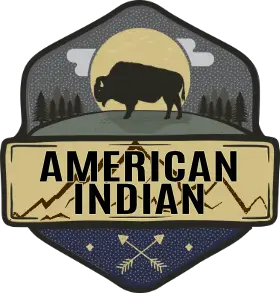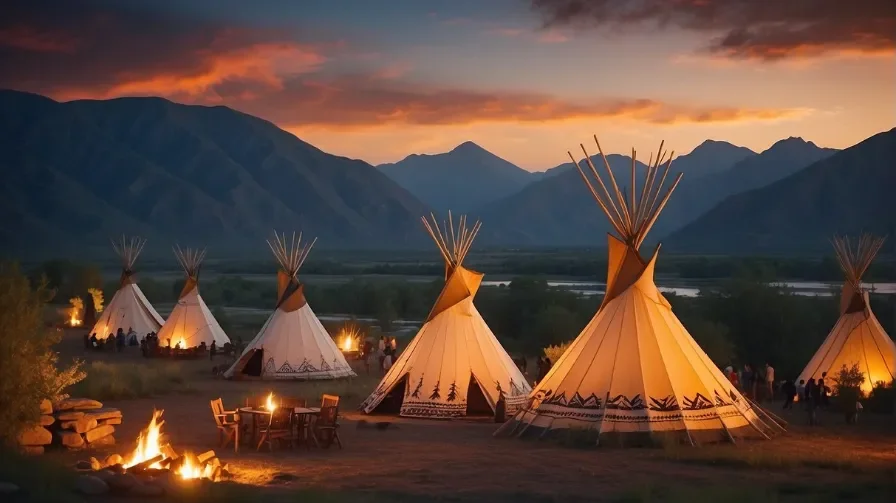Native American Tribes & the Indian History in Clintonville, Pennsylvania
The history of Native Americans is often distilled into neat chapters: the arrival of Europeans, the expansion of the frontier, the resistance and removal of tribes.
But the real story does not begin with colonial ships cresting the horizon, nor does it end with the closing frontier. It’s an ongoing epic that stands intertwined with the very identity of America.
I want you to know of a vibrant mosaic of pre-colonial societies, invaded, suppressed, and the struggles that still echo in native communities today. More than just a relic of the past, it’s a living chronicle that deserves attention.
The Diverse Mosaic of Pre-Colonial Indigenous Cultures
In the vast expanse of North America, before the sails of Europeans billowed on the horizon, there thrived an intricate tapestry of indigenous peoples. Each thread in this fabric-a society, a tribe-was unique, woven with its own patterns of culture and tradition.
From Clintonville, Pennsylvania to either coast there was indigenous culture. They were as varied as the landscapes they inhabited, from the dense forests of the northeast to the expansive prairies in the heartland, and the arid deserts of the southwest to the rugged coastlines of the northwest.
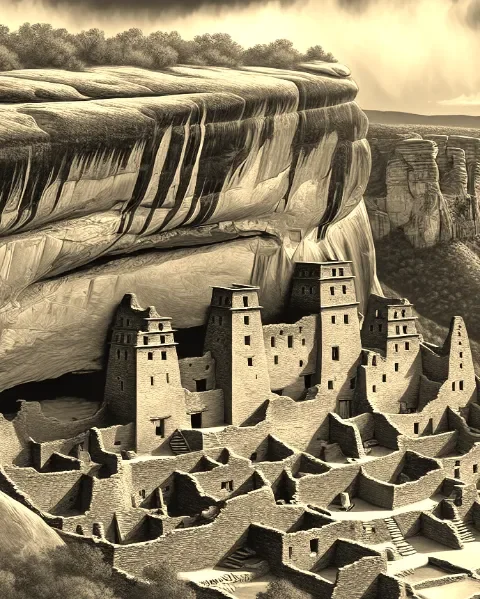
These societies were far from simplistic; they bore complex social structures that intricately organized their members from birth to death. There were leaders and council members, warriors and healers, craftspeople and storytellers, each with roles as important as the next in maintaining the equilibrium of their communities.
And fundamental to their existence was their relationship with the land. It was not merely a backdrop for their lives but a central character in their unfolding stories. They knew the songs of the rivers and the whispers of the wind through the grasses.
They understood the subtle language of the earth and responded with reverence. Their respect for nature was not borne out of idleness but out of a profound awareness that their lives were deeply interconnected with the world around them.
In this way, they lived-not as mere occupants of a geographical space but as participants in a grand ecological dialogue that had been ongoing long before their time and would continue long after.
Each day was another verse in a song as old as the mountains, a song that sang of belonging to a world far richer and more beautiful than any one individual could claim or own.
Powerful Confederations that Shaped the Land
In the Northeast, a great alliance known as the Iroquois Confederacy rose. It was not just any alliance, but a sophisticated gathering of tribes bound by political and military aims.
Their governance was a mirror of the Native diplomacy, an intricate system that respected the voices of its people and sought unity in decision-making. It was a testament to their deep understanding of leadership and cooperation among diverse groups.
Far to the Southwest, the land tells another tale where the Puebloan Peoples etched their existence into the earth’s rock. They raised majestic cliff dwellings and grand adobe structures that stood against the test of time.
These people were not just builders; they were skilled farmers who coaxed crops from the arid land, engineers who crafted their homes in harmony with the unforgiving landscape, and astronomers who read the stars as one reads a book, learning the secrets of the skies.
In the Southeastern woodlands, the Cherokee thrived as one of the most populous groups. Their society was rich and complex, with an intricate clan system at its core.
Kinship followed the maternal line, painting a picture of a society where relationships and familial ties were traced through mothers and grandmothers.
This matrilineal pattern was a thread that ran strong through the fabric of Cherokee life, influencing their social structure, inheritance, and even leadership.
Find Native American Indian Jewelry in Clintonville, Pennsylvania
Beliefs and Traditions Forged Over Millennia
In the oral histories of pre-colonial societies, creation stories are woven into the very essence of Native American existence. These origin stories are not mere tales but are the sinews connecting the people to their lands and sacred sites, each narrative a map of spiritual geography.
Like the roots of an ancient oak, these bonds run deep, anchoring tribes to places where the earth speaks of their genesis and their gods walked. Ancestors step through time with us.
The land is alive with spirits in these animistic belief systems, where every rock, tree, and stream is imbued with a life force. As Chief Seattle pointed out in an 1854 address, the rocks themselves hold memories and the dirt beneath our feet is sympathetic in its touch.
The shaman stands as a bridge between the human world and the spirit world. They are the keepers of mystic knowledge, traveling on soul journeys to negotiate with spirits, heal the sick, and guide the community.
Reverence for nature is not just a practice but a way of being. Nature’s cycles dictate the rhythm of daily life, and in this reverence, there is a profound harmony with the environment.
To live is to honor the spirits in all living things, a respect that is both deep and abiding. Among the first nations, the cry to preserve Unci Maka (Grandmother Earth) is the call to protect family.
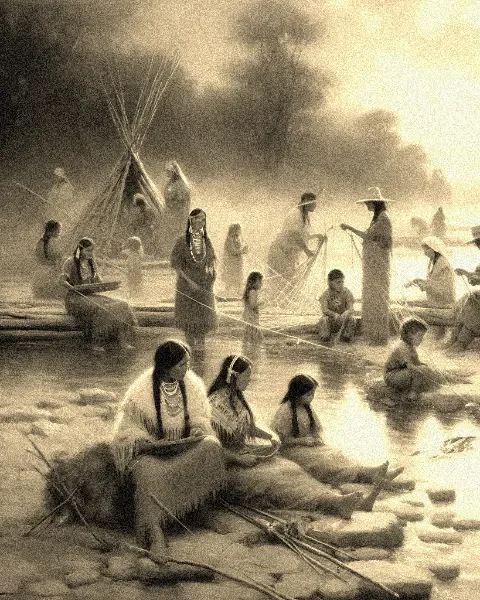
Ceremonies are the heartbeat of the community, marking the passage of time and celebrating the continuum of life. These sacred rituals are not just events but are living histories told through the vibrant threads of oral traditions.
The beat of the drum and the rise of song are not merely music but are stories and prayers given wings. The visual arts are not just decoration but are stories etched into stone, woven into baskets, painted on hide. We powwow to honor each other, and to bring life to the ancestral ways that set us apart from non-natives.
Each dance, ritual or ceremony is a chapter of a larger story, telling of victories, losses, dreams, and fears. The artistry is a language often beyond words, a communication of the soul’s journey through this world and beyond.
In this simple yet profound existence, pre-colonial Native American societies crafted a world rich with meaning, where every element of life was intertwined with cultural and spiritual significance.
Find Native American Indian Art in Clintonville, Pennsylvania
Agricultural Innovations that Transformed the Wilderness
In the era before the colonizers came, the native peoples of what we now call America were not idle. Their hands, wise from the pulse of the earth, coaxed the soil into life-giving abundance.
Among their most elegant horticultural ballets was that of the “Three Sisters” – corn, beans, and squash, growing together in harmony. The corn stood tall, its stalks like the masts of green ships.
Beans twined around those stalks, reaching for the sun, while the squash spread its leaves across the earth, a living mulch to cradle moisture. This trio not only provided a balanced diet but also spoke of a deep understanding of agricultural interdependence.
Water, as ever, was both friend and foe-the lifeblood of crops and the sudden destroyer of fields. Through ingenuity, channels and ditches were transformed into arteries of life, directing the precious liquid to thirsty plants.
And with careful stewardship, fertilization practices enriched the depleted earth without demanding more than it could give, ensuring that the soil could continue to sustain their children’s children.
The hunt, too, was a testament to their intimate knowledge of the land. With tools shaped from bone and stone, they harvested the gifts of forest and stream. These tools were not just instruments of survival but reflections of the ecosystems they inhabited-each hook and arrow perfectly married to the fish it sought or the game it pursued.
Trade was not conducted in silence but through a vibrant network of routes that pulsed across the continent like veins. A web of exchange connected tribe to tribe, culture to culture, allowing for the movement not just of goods but of ideas-each exchange a conversation, each trade a tale.
And within their settlements, evidence of urban planning whispered of a sophisticated understanding of community and space. Networks of trails stitched the land together while canoes slipped through waterways as easily as needles through cloth.
Their cities were not haphazard but laid with intention, a reflection of their deep connection to both each other and the earth. Such was the landscape for those who walked these lands in the time before history turned its page.
The Arrival of Columbus and Age of Exploration
In the waning years of the fifteenth century, a man named Christopher Columbus, an Italian navigator at sea under the flag of Spain, crossed the uncharted waters of the Atlantic. The year was 1492, a year that would become a hinge upon which the world’s history would pivot.
Columbus set foot upon the shores of the Caribbean, his eyes open to new horizons but blind to the complex views of life and civilization that had thrived there long before his sails kissed the horizon.
In the years following Columbus’s arrival, the Spanish, with their armor glinting under the foreign sun, began to exert their influence into these newfound lands. They planted their colonies with the determined hands of those who believed they were ordained to tame, teach and pillage.
Florida and the vast Southwest became dotted with missions, outposts of religious zeal where cross and crown worked hand in hand to fleece, convert and command.
This era was driven by an insatiable hunger for wealth and the fabled cities of gold that danced like mirages before the eyes of explorers. These adventurers, conquistadors, and settlers were pulled forward by dreams of ore-fueled opulence.
Driven by whispers of untapped resources waiting beneath the soil or through trade routes yet uncharted, they set forth. Their footsteps marked the beginning of a transformation that would echo through the ages, as two worlds collided with both wonder and woe.
Empires Stake Their Claim
In the sprawling tale of the New World, the paths of the French and British, though both hungry for prosperity, diverged in the wilderness of opportunity. The French, with a light touch, wove themselves into the fabric of the land through the fur trade.
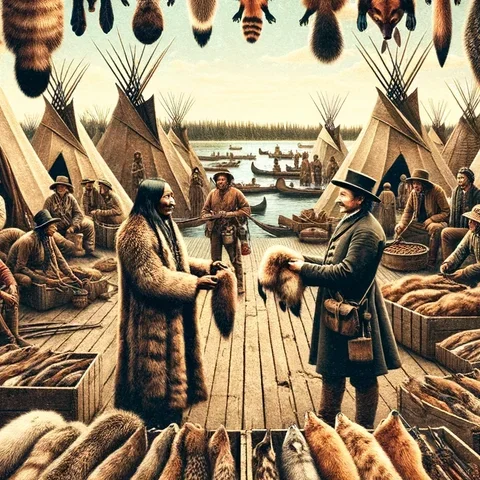
They reached out to the native tribes with a trader’s handshake, forming bonds and alliances that ran as deep as the rivers they navigated. Theirs was a commerce of pelts, and their settlements were often no more than outposts, specks on the vast canvas of forests and lakes.
The British harbored a different dream. They came not just to visit and trade but to stay, driven by a vision of permanent colonies.
In Virginia, 1607 marked the year their dream took root in the form of Jamestown. This was not a mere trading post but a foothold, a declaration of presence and intent.
Here, the British planted their flag and unfurled their ambitions, tilling the soil and laying the stones for what they hoped would be a new dominion under their crown.
Both nations, in their pursuit, would entwine with the lives of Native Americans – the French through a mutual need for goods and goodwill, the British through a steadfast resolve to carve civilization from the wilderness.
Each encounter, each alliance, and each settlement wove into the story of a land in the midst of great change. Agreements were tenuous, as native leaders soon learned that Eurpean promises were unlike they expected.
Uneasy Relations and Broken Promises
In the early encounters and colonization of what would become the United States, a network of trade and cooperation was woven between the colonists and Native Americans. These initial interactions were often driven by necessity and the mutual benefits of exchange.
The colonists, eager for survival and prosperity in a new world, sought the knowledge and resources that the Natives had cultivated over countless generations. Likewise, some tribes found advantage in the tools and trinkets the newcomers brought with them.
However, beneath the surface of these dealings, a current of cultural misunderstandings ran deep. Simple gestures and words, clouded by the fog of vastly different worldviews, sparked frequent skirmishes. Such clashes sowed seeds of distrust on both sides, as each struggled to navigate the intentions of the other in this emerging world.
The colonists, armed with a mindset of expansion and often backed by distant crowns, turned to treaties as a means to formalize their ambitions. These documents, cloaked in the language of mutual agreement, were frequently tilted to serve the colonial interests.
They promised peace and partnership but were laced with terms that favored the expansion of European settlements at the cost of tribal sovereignty. This strategy would leave a lasting imprint on the landscape of American history, shaping the complex relationship between Native Americans and settlers for centuries to come.
Find Native American Indian Music in Clintonville, Pennsylvania
Defiance in the Face of Conquest
This was a time when individual native leaders, with limited diplomatic experience and information, stood at life’s crossroads. Massive decisions, such as choosing paths of cooperation or resistance, would impact tribal history.
Some sought to weave bonds of cooperation, understanding that the strange new settlers brought with them both danger and opportunity. They reached out, hoping to blend the strengths of both peoples like streams joining into a mighty river.
Their vision was of a shared world, where the exchange of goods, ideas, and cultures could flourish like a field nourished by diverse rains. Naive? Perhaps so.
But no Europeans arrived on these shores with such innocence. They’d left a continent in constant turmoil, where notions of conquest and land ownership were foundational.
As the new world grew crowded, native hopes dimmed like the last light of day. The French and Indian War erupted, a brutal reminder that coexistence is a delicate bloom that wilts in the shadow of greed.
The colonists, once seen as potential partners, became adversaries in a struggle for land and power. The Natives found themselves caught in the crushing gears of an unstoppable force, their way of life threatened by an insatiable hunger for expansion.
And European diseases began to sweep through Native America like wildfire. These afflictions were unkown to natives and thus there was little to no immunity.
Over the years that followed, many tribes were decimated by illness. Some were made extinct, while others merged bands into new nations.
Tribal confederacies were formed to strengthen resistance to the settler encroachment and to provide a stronger voice in negotiation. But it remained a dark period of cultural and physical battle.
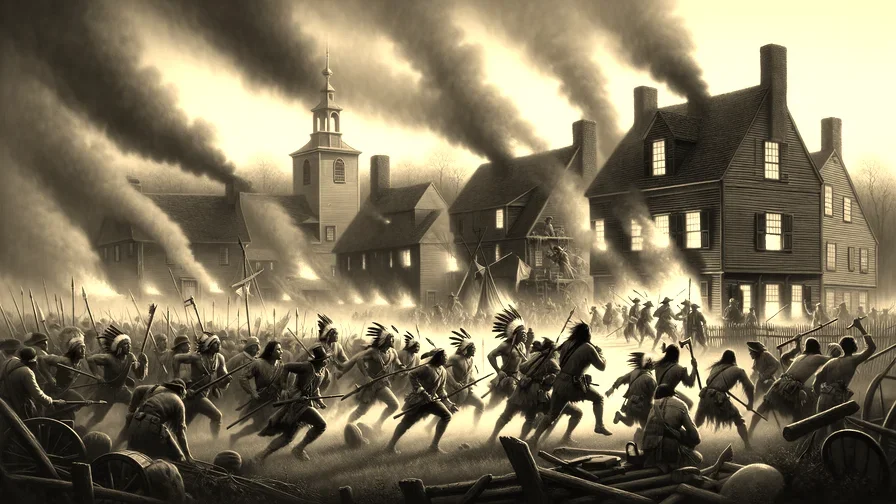
From the ashes of conflict rose a leader named Tecumseh, a name that would come to symbolize resistance in the face of overwhelming odds. In the early 1800s, as American expansion pressed relentlessly westward, Tecumseh stood firm, a bold silhouette against the encroaching tide.
He understood that unity was the only bulwark against displacement and destruction. His voice rang out, urging disparate tribes to stand together as one to protect their homes, their families, and their future.
Tecumseh’s vision was clear: only through unity could their way of life survive the relentless march of American settlers pushing ever westward. This period of early encounters and colonization was marked by the interplay of cooperation and conflict, visionaries and warriors, and the unstoppable currents of change.
It was here that the foundations were laid for the intricate relationship between Native Americans and the United States – a relationship as complex as the patterns on a woven blanket, each thread a story, each color a memory.
A Century of Betrayal and Heartbreak
In the 19th century, a sorrowful chapter was written in the history of Native Americans, headlined by events surrounding the Indian Removal Act of 1830. This legislation, signed into law by President Andrew Jackson, became a tool for enacting a policy of forced relocation.
It dictated that tribes living east of the Mississippi River were to be moved to lands in the west, to spaces that were foreign and distant from the ancestral homes they had known for countless generations. Its basis was to put ownership of fertile and resource-rich lands on the Eastern seaboard into the hands of colonists.
The Cherokee, along with other tribes, found themselves at the heart of this brutal policy. They were compelled to leave behind their homesteads, their fields, the graves of their ancestors, and embark on a journey that would be etched in history as the Trail of Tears.
This was no ordinary travel; it was a march laden with suffering and sorrow. Men, women, and children faced the unforgiving elements of Winter, disease, and scarcity of provisions.
As they traversed over a thousand miles, often in chains and under the watchful eyes of an indifferent military escort, thousands succumbed to the ordeal. They perished not only from the physical hardships but also from a profound sense of loss.
The reservation land allocated to the tribes, in what is now called Oklahoma, was undeveloped and harsh. There was much death and poverty still to come for those who survived foreced removal, as tribal leaders fought to secure resources for survival in exile.

The Trail of Tears stands as a testament to their endurance but also as a stark reminder of the cruelty they faced – a forced expulsion that reshaped the landscape of Native American life in the United States forever.
It was an early example of the (primarily) British notion of Manifest Destiny. The Christian majority within those waves of settlers was convinced that God had ordained their possesion of North America, and it was communicated far and wide.
Find Native American Indian Clothing in Clintonville, Pennsylvania
Exile and Death on the Trail Where They Cried
In the late 19th century, the fabric of Native American life was being deliberately unraveled by the hands of those who saw their vibrant cultures as obstacles to progress. The Dawes Act, a policy cloaked in the guise of benevolence, sought to strip the tribes of their collective identity by parceling out their land to individuals.
It was an era where policymakers, reinforced by Christians hungry for converts, believed that the native way of life was something to be corrected rather than preserved. Boarding schools swept indigenous children away, refusing them cultural practices like language, dress and traditional hair style.
Despite these forceful tides of assimilation, the spirit of Native cultures displayed a resilience as enduring as the earth they cherished. They held fast to their traditions, their languages, and their identity amidst a sea of change.
For many tribal nations, these embers were concealed from the colonizers to minimize retribution. But each policy that aimed to erode their community, resulted in ways to adapt without surrendering their essence.
The struggle was not solely for the preservation of culture but also for the basic rights that were long denied. Native Americans fought tirelessly for recognition and citizenship within a land that was once solely theirs.
This battle was marked by both quiet acts of defiance and loud cries for justice, weaving a tale of perseverance in the face of overwhelming odds.
Cultural Resilience Despite Relentless Attacks
In the 19th century, as the United States expanded its territories westward, the people who lived on the land faced the encroachment of an ever-growing nation. The Apache, a fierce and proud group of loosely-connected bands, stood their ground against this invasion with celebrated leaders like Geronimo.
They knew the mountains and the deserts; they were part of the land, and the land was part of them. With their profound connection to their homeland and their adept skills in guerilla warfare, they resisted with arms, fighting to preserve their way of life against those who sought to claim it for their own.
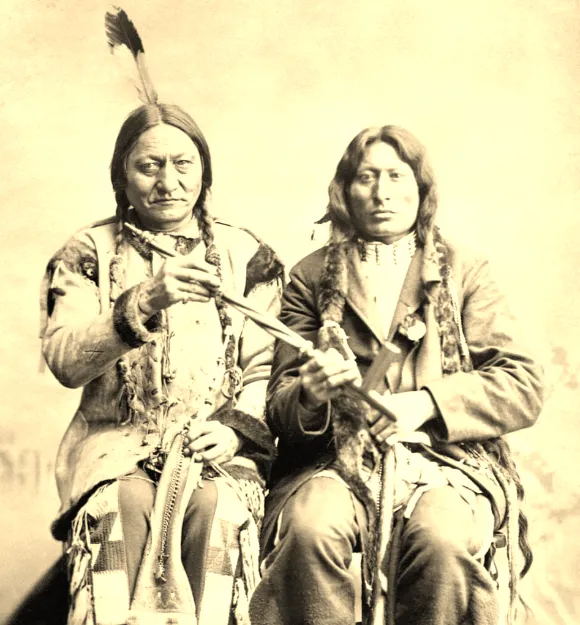
Not far from these struggles, two notable leaders emerged among the Lakota Sioux: Sitting Bull and Crazy Horse. They did not seek conflict but were propelled into it by the relentless push of settlers and gold-seekers into the Black Hills, a place sacred to their people.
Sitting Bull, a chief and holy man, possessed a quiet strength that resonated with his people, inspiring them to stand firm. Crazy Horse, with the fire of a warrior’s spirit, led with a daring that became legend. Together, they united their people in an act of defiance that would echo through history.
There were moments when this resistance sparkled with victories that shone like flashes of light in a long, dark night. At battles like Little Bighorn, these leaders and their warriors demonstrated their might and determination, proving that their spirit would not be easily extinguished.
But these brief triumphs were like fleeting whispers in the wind, as the might of an expanding nation brought about clashes that were ultimately destructive.
These conflicts, marked by bloodshed and loss on both sides, were but one chapter in a longer saga of struggle and resistance. Though the outcome was shadowed by sorrow, the legacy of these fighters endures-a testament to their unyielding courage and love for their homelands.
The Ongoing Journey: Struggles and Revitalization
In the evolving story of America, the chapters concerning its native sons and daughters are tinged with a persistent struggle for rights once promised. As we cast our gaze upon the modern tableau, we see that the activism rooted in the hearts of native tribes is as fervent as ever.
They stand not merely as figures of the past, but as living participants in the nation’s ongoing narrative, seeking acknowledgment of treaties forged in yesteryears – pacts that bound their ancestors and the fledgling government in a mutual embrace that has since frayed.
Fishing rights, a staple of life and culture for many tribes, have transformed into a contested arena where the lines drawn by treaties are defended with the tenacity of those whose very heritage hinges upon the rivers and streams of their lands.
These waters, teeming with life, are not just sustenance but are fundamental to tribal identity. The disputes over land use, too, are emblematic of a broader contention; it is a clash between the traditional guardians of the territories and those who see the land through a different lens-a resource to be tapped and transformed.
The tribes, in their advocacy, do not simply ask for favors; they demand that the agreements of old be respected, that promises made be honored. Their voices rise in council halls and courtrooms alike, echoing off walls that have too often been deaf to their pleas.
Yet still they speak, for silence would mean the surrender of ancestral rights-the very soul of their communities.
Battles to Uphold Promises of the Past
In the heart of America, where the spirit of native communities beats with a rhythm handed down through generations, there is a shadow that stretches long and weary across the land. It is a shadow cast by systemic inequality, a specter that haunts the health and wellbeing of these storied people.
These communities, rich in tradition and steeped in the lore of the earth, confront disparities in health that cut deep furrows into their collective soul. Access to healthcare-a fundamental right as vital as water to the parched-is woefully inadequate in native lands.
The clinics and hospitals, when they exist, are often miles upon miles away, across rugged terrains and through the whispers of winds that have seen better times. The doctors and nurses are too few, their hands tied by the red tape of bureaucracy and the scarcity of resources.
Life expectancy, that most basic measure of wellbeing, falls short among these original inhabitants. The men and women watch, with a quiet sort of dignity, as their time under the sun ticks away faster than it should-faster than it does for those in bustling cities with gleaming hospitals.
There is a resignation in their eyes; a knowledge born of centuries of promises made and broken.
The roots of this grim reality are traceable, like the lines on a withered leaf, to government policies etched into history. These policies are not mere words on paper but have been the architects of sorrow in native lives.
They speak of times when land was taken and treaties were disregarded, when children were pulled from the warmth of their families to be molded into images that were not their own.
The legacy of those times lingers, like the last notes of a drumbeat fading into the night. But even as the night is deep, there is a stir within these communities-a renaissance of culture that refuses to be silenced. In this modern age, native voices rise in a chorus that seeks to reclaim their health, their sovereignty, their very identity.
Revival of Traditions Once Suppressed
In the heartland of America, where the memory of the land and its original peoples run as deep and enduring as the rivers, there has been a stirring-a renaissance of the spirit, a cultural resurgence through the medium of arts.
The native tongues, once on the brink of silence, are finding their voice again, articulated in classrooms and ceremonies, cradling the wisdom of ancestors. This revival of indigenous languages is not just a recovery of words lost, but a reclamation of history and identity.
In the same breath, traditions that have waned under the weight of time are being rekindled. These practices are being woven back into the fabric of daily life, honored in dances, in the sacred rituals, and in the stories that are once again being shared among the young and old.
Artistic expressions, too, have found new soil in which to bloom. Music-rich with the pulse of the drum and the call of ancient flutes-now also merges with contemporary beats, giving voice to the past and present in a single melody.
Literature has become a vessel for the once untold narratives of an entire people, penned with truth and vibrant imagery. The visual arts have undergone a transformation as well; canvases are splashed with colors that speak of old legends and current struggles, sculptures carved with the resilience of generations.
This cultural pride that has been forged anew does more than just celebrate customs; it reinforces a sense of identity. A people once scattered and silenced now stand united and expressive.
This is a story of reclamation-an era where every song, every word written, every stroke of the brush is an assertion of existence, a declaration that they are still here, still strong, and forever enduring.
Seeking Wellness and Equal Standing
In the heart of colonized America, the indigenous spirit of self-determination beats with a rhythm as old as the land itself. Tribes have found a novel means to weave the fabric of autonomy – casinos and gaming.
Like the mighty rivers that carve their paths through the earth, these establishments have become channels promising prosperity flows for native communities. With each roll of the dice and spin of the wheel, there is more than a game of chance; there is a play for sovereignty.
It is not just the clatter of slot machines, but the sound of self-reliance that echoes through these halls. The revenues generated are the sinews that strengthen tribal governance, allowing for a renaissance of independence.
Schools, hospitals, and infrastructures bloom from this fertile financial ground, nurtured by the hands that once were tied by economic dependence on a hostile government. The casino lights, bright as the North Star, light the way to a future envisioned by generations past.
These business ventures are more than mere commerce; they are the drums of progress, beating a message of hope and renewal. Each successful enterprise is a testament to a tribe’s ability to adapt and thrive in the modern world while honoring the sacred traditions that define their past.
This symbiosis of culture and commerce is a symbol of greater economic independence – a sign that the long winter of economic disenfranchisement may be giving way to a springtime of possibility.
Regrettably, many nations are divided about gaming. It’s not so much centered around the morality of gambling, though. Many members feel that casino profits aren’t trickling down fairly, and there’s been calls for tribal leadership to be more transparent about financial dealings.
That’s not across the board, of course. But poverty on reservations is still commonplace, even in the shadows of neon-lit gaming halls with 24-hour traffic.
As these indigenous nations chart their course through the waters of self-governance, they steer by stars unseen by others-stars of resilience, stars of community, stars of an enduring identity that can never be gambled away.
A Few Final Thoughts
The story of Native Americans in the U.S. is one of vibrant, complex societies evolving over thousands of years, deeply connected to the land. Initial periods of trade and cooperation with European settlers gave way to encroachment and conflict as colonial ambition clashed with tribal autonomy.
Despite forced relocations, efforts to undermine their culture, and the profound loss of life and land, Native peoples persevered through ingenious adaptation and determined resistance. Leaders like Red Cloud, King Philip and the great Lakota warriors Sitting Bull and Crazy Horse stand as symbols of this defiant spirit.
Yet the legacy of systemic injustices persists today in underfunded services, healthcare disparities, and ongoing struggles to uphold treaty rights. However, as seen in the revival of native languages and arts, along with economic drivers like tribal gaming, Indian Country is undergoing a bit of a renaissance.
Rooted, I feel, in enduring values of community and reverence for their homelands, Native Americans are reclaiming their heritage. On their own terms, writing new chapters in an epic, living narrative.
Though steeped in hardship, their story continues writing chapters. The resilience, solidarity, and an indomitable sense of identity preserved heritage in the face of savage assimilation efforts of the early 20th century.
